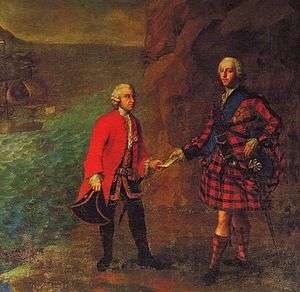Antoine Walsh
Antoine Vincent Walsh (1703 – 1763), was an Irish-born shipowner and slave trader, operating in Nantes, France; whose family were exiled Jacobites.
Early life
His father was Philip Walsh, a Waterford merchant, who settled in Saint Malo about 1685, and who would die at sea on an African voyage. It was Philip who had conveyed the defeated James II of England from Kinsale,Ireland to Saint Malo, France in 1690 after the Battle of the Boyne thus starting the family connections to the Stuarts.
Antoine was born 22 Jan in Saint Malo. After serving in the French navy, he ettled in Nantes which had emerged as the France’s chief slaving port; where he found advantage in its close-knit Irish community.
Career
He became a merchant was a major figure in and made a fortune from the slave trade of Nantes.[1] slave-trading and plantation-owning had made him the friend of kings. Antoine became wealthy on the back of the slave trade. The trade operating in a triangular fashion, supplying Africa with textiles, brandy, and firearms); slaves for the French West Indies in Martinique, Guadeloupe and Saint-Domingue; sugar and tobacco for Europe.
Marriage
In 1741 he married Mary O'Shiell a French-Irish businesswoman in Nantes in France, where she is a known figure in the history of Nantes, alongside her sisters Agnés O'Shiell and Anne O'Shiell. She was the daughter of the Irish Jacobite Luke O'Shiell (1677-1745), who was born in Dublin but emigrated to Nantes after the Irish defeat, and Agnès Vanasse (1690-1724). The family manor of the O'Shiell, Manoir de la Placelière, became the gathering place of the large Irish colony in Nantes.
1745

In 1744 he commissioned a new French privateer the Du Teillay (18 guns), in Nantes. She played a central role in the Jacobite rising of 1745, ferrying Charles Edward Stuart to Ardmolich with supplies and funds to support his cause.[2]
He took a leading role in the French Irish community's financing and planning and of Charles's expedition to Scotland, the 1745 Jacobite rising, and was a key figure in all aspects of the naval side of the rebellion. In his correspondence with the Prince, Walsh adopted the pseudonym Monsieur Le Grand and the young prince was called Mr Douglas; they also had face-to-face planning meetings at Navarre in April 1745. Antoine accompanied the Prince on the journey on board the Du Teillay (Captain Claude Durbé) on 7 July at Saint-Nazaire and they were joined by French escort waarship the L'Elisabeth, bound for Ardmolich in Scotland. Two days later on the 9 July 1745 they were intercepted off the Lizard by HMS Lion, and were severely impeded in their mission when they exchanged fire, the Elisabeth was so badly damaged she had to return to port taking the arms and Irish volunteers with her.
The Du Teillay and was obliged to continued alone eventually arriving at Eriskay in the Outer Hebrides on 2 August, they then sailed onto Loch nan Uamh and two days later Antoine had to take his leave for France, leaving Charles with his eight companions to proceed to Glenfinnan where on 19 August 1745 he raised his Standard, despite having no money and no supplies.[3]
In the same year Antoine's second son, Antoine Jean Baptiste Walsh (1745-1789) was born.
Coincidentally Charles was to return to Loch nan Uamh by the 20 September 1746 to the nearby Prince's Cairn, which marks the spot where he finally left Scotland forever on a French ship after the unsuccessful Rebellion.
Château de Serrant
In 1749, Antoine bought the Château de Serrant and its estate from the last surviving descendant of the de Bautru family. The Walsh family set about redecorating the interior of the castle, they built an English style park, pavilions, and a monumental gate complete with the family crest. The château eventually passed out of the hands of the Walsh family in 1830 when Valentine Eugénie Joséphine Walsh de Serrant married the Duc de La Trémoïlle (1764–1839). La Trémoïlle set to the task of restoring the castle and added several features, including parapets and cornices. The La Trémoïlle family still own the château.
Later life
In 1755, the O'Shiell family became ennobled.
References
- ↑ "History Ireland". History Ireland. 2007-05-13. Retrieved 2016-12-03.
- ↑ "Action between HMS Lion and Elizabeth and the Du Teillay, 9 July 1745 - National Maritime Museum". Collections.rmg.co.uk. Retrieved 2016-12-03.
- ↑ "Charles Edward Stuart: Biography on Undiscovered Scotland". Undiscoveredscotland.co.uk. Retrieved 2016-12-03.
- ↑ ""pierfit" - Geneanet". Gw4.geneanet.org. Retrieved 2016-12-03.
- ↑ "Quelques familles de négociants angevins et nantais dans la colonisation. - Balades en généalogie". L-ardoise-fine.over-blog.com. Retrieved 2016-12-03.
- ↑ "Bretagne et Irlande dans l'histoire by yann rivallain". Issuu.com. 2009-09-02. Retrieved 2016-12-03.
- ↑ "Château-Thébaud : Histoire, Patrimoine, Noblesse (commune du canton de Vertou-Vignoble)". Infobretagne.com (in (French)). Retrieved 2016-12-03.
- ↑ "Héraldique : logiciels de dessin et de recherche de blasons". Euraldic.com. Retrieved 2016-12-03.
External links
| Wikimedia Commons has media related to Antoine Walsh. |